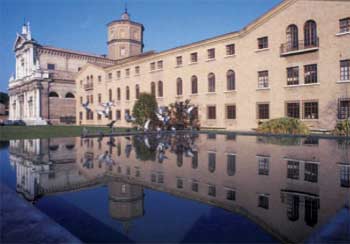
MUSEO D'ARTE DELLA CITTA'
LOGGETTA LOMBARDESCA
Via di Roma 13
tel. 0544/482356
![]() critical text by Elettra Stamboulis
critical text by Elettra Stamboulis
It
is not incidental that Salvatori, in the planning stage, drew his inspiration
from an image which alludes to one of the most cruel novels ever written,
Gulliver's travels : his works have, in a way, the same tricky
ambiguity to which Swift's novel is linked. This book, that superficially
looks like an escapist novel, and it is even considered a book for children,
is in fact a philosophical novel, or to be more precise a dialogic one,
where the values of western culture are challenged and redefined. As Gulliver,
the narrator of the book, Salvatori finds his own position and plays the
mediator between the work and its viewers. He is there, with his unmistakable
mischievous moustache, but often hidden at first sight.Another element
these works have in common is the literalization of the metaphor, a technique
used in the novel in Lilliput's episode and actualised in Salvatori's
artistic works. What art does is, after all, actualising the rhetorical
techniques.Salvatori is constantly playing with signifiers and body. He
works with ceramics, but in his hands these objects are transformed, they
are freed from their status of ornamental and serial statuettes. They
lose their meaning and acquire a new one through interpretational slips,
through small changes which modify their function: they are no longer
synonym of easy enjoyment, but they carry disturbing semantic puns.The
stiff knight in gloomy armour keeps attracting young maids that cannot
stop kissing his lips. Maybe the red lipstick halo on his lips will be
erased by the restauration but this won't certainly diminish the romantic
aura of this work. The contemporary artist is hiding: is he the assailant
of the victim of the assault?

